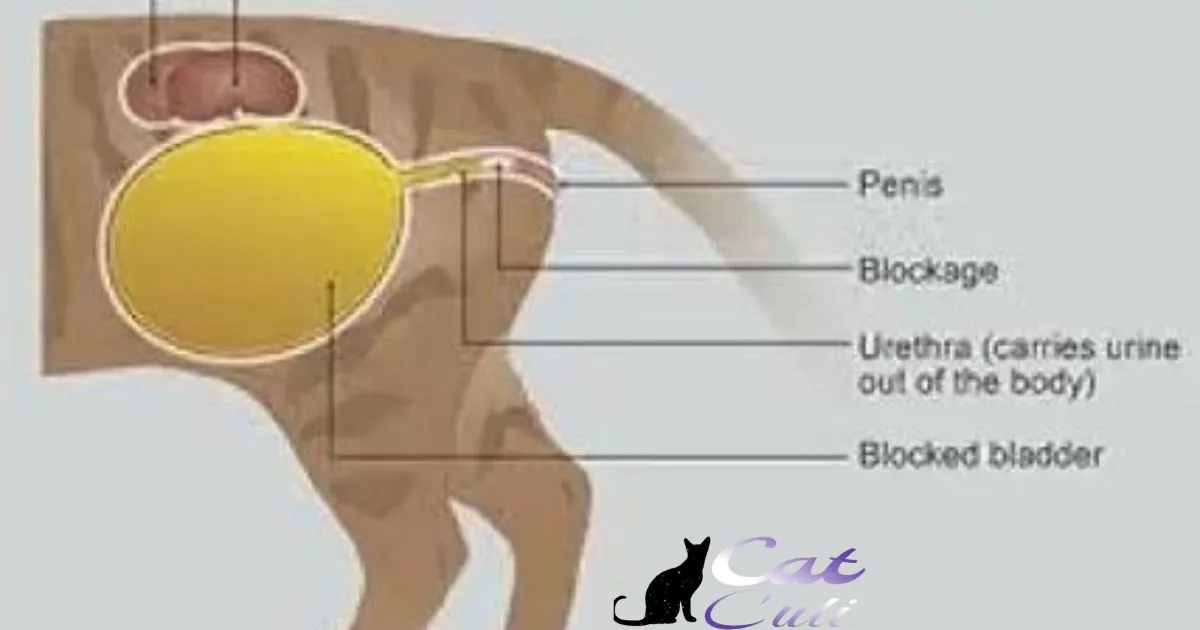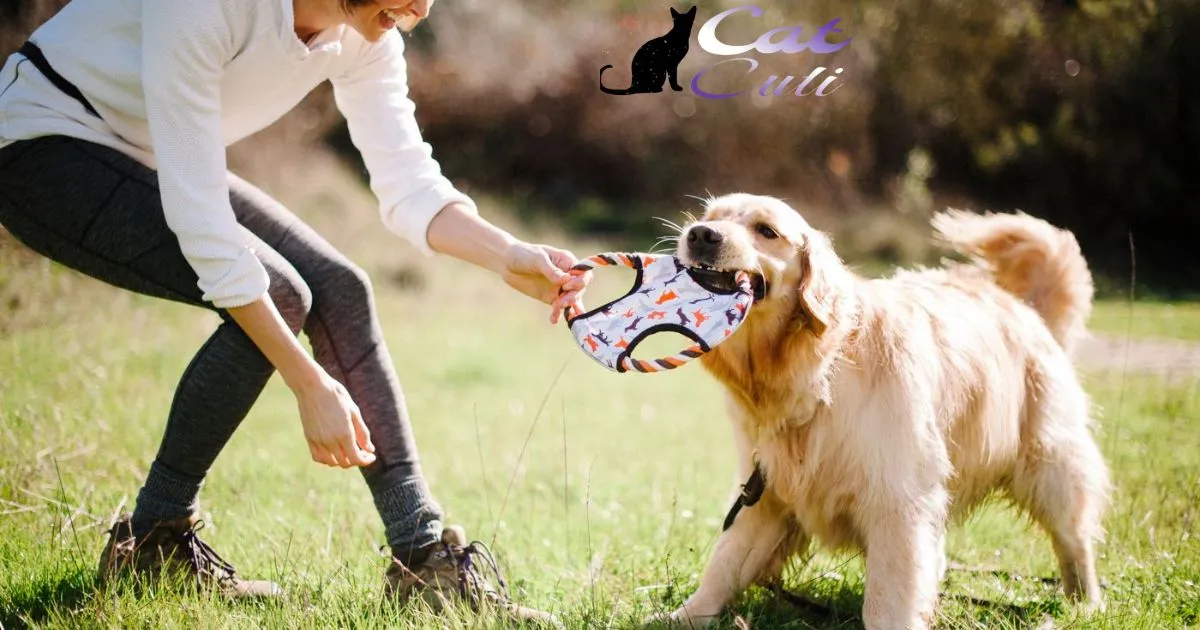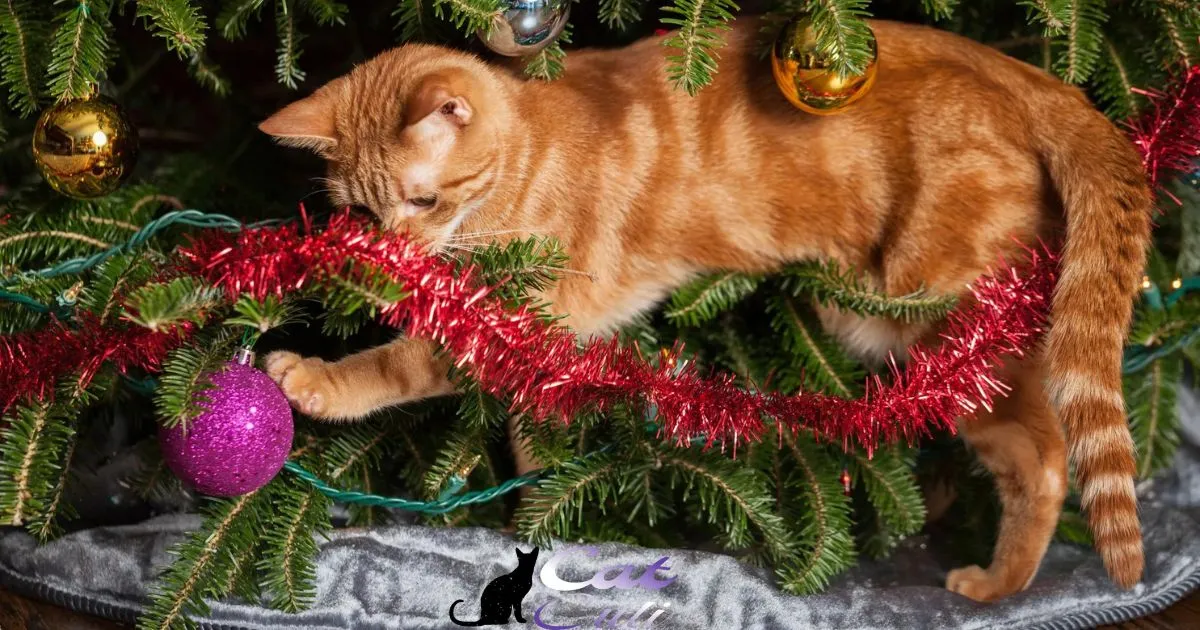The twinkling lights and glittery ornaments of a Christmas tree captivate both humans and curious cats alike. However, feline fascination with these festive fixtures often turns into chaotic chewing, batting, and climbing. Cats find the low-hanging branches and dangling decorations on artificial trees impossible to resist.
A cat chewing on a fake Christmas tree seems like a harmless source of entertainment. But ingesting pieces of plastic, metal, and fabric poses some real risks. Cats can choke on fake pine needles, cut their mouths on ornament hooks, or develop intestinal blockages from eating tree components.
While our furry friends mean no harm, their rough play doesn’t mix well with delicate holiday adornments. With some strategic planning and training, both cats and Christmas trees can coexist in harmony. A few modifications allow kitty curiosity in a safer outlet so everyone enjoys a cheerful, decorated home during the holidays.
Keeping Your Cat from Chewing on the Fake Christmas Tree
Focused on providing pet parents with tips, advice and information to deter cats from chewing fake Christmas trees
Having an artificial Christmas tree can be a fun, festive way to decorate for the holidays. Curious cats may view the fake branches and needles as intriguing toys.
Chewing on and ingesting pieces of the artificial tree can potentially cause blockages or other issues. This article explores why cats are attracted to fake Christmas trees, dangers associated with chewing, and most importantly, effective tips to keep your cat from treating the festive decoration like a snack.
Why Cats Are Drawn to Chewing on Artificial Christmas Trees
Cats tend to chew on non-food items like houseplants, fabrics, paper and even plastic or faux plants for a variety of reasons:
Boredom and Stress
A cat that lacks sufficient mental stimulation or is feeling stressed may turn to inappropriate chewing as an outlet. The texture and movement of branches on the Christmas tree can seem like an appealing toy.
Attention-Seeking Behavior
Chewing on off-limit items like the fake Christmas tree may be your cat’s way of acting out to get your attention. Scolding or interacting with them, even negatively, rewards the behavior.
Instinct to Chew Plant Material
In the wild, cats chew on grasses and other plants to ingest fiber and facilitate digestion or vomiting. The green needles and branches of a fake Christmas tree can trigger this instinct.
Health Issues
Sometimes excessive or inappropriate chewing or licking can signal an underlying medical issue like dental problems, gastrointestinal issues or nutritional deficiencies. Check with your vet if you notice a sudden increase in chewing behaviors.
Dangers of Chewing Artificial Christmas Trees
It’s crucial to be mindful of various factors when it comes to cat behavior and safety. For instance, understanding the cat tail length can determine the size of objects they might be tempted to chew on, helping to create a safer environment for our feline friends.
Gastrointestinal Blockages or Damage

Ingested pieces of plastic pine needles or bits of branch could accumulate in the stomach or intestines, causing a blockage. Sharp pieces may also damage or puncture the digestive tract.
Choking Hazards
Large pieces of chewed-off branches or broken ornament hooks can become lodged in the mouth, throat or esophagus.
Plastic Toxicity
While rare, some cats may experience lethargy, vomiting or other symptoms from ingesting plastic particles, chemicals or dyes from artificial plants.
Electrical and Fall Hazards
Chewing through light strings or wires poses a risk of burns and electrical shock. Climbing the tree also risks knockdowns and injury.
How To Stop Cat From Eating Artificial Christmas Tree
| Goal | Method | Explanation |
| Make tree taste bad | Use bitter apple spray | Cats dislike bitter tastes. Spray it on the tree. |
| Cover tree base | Use foil or plastic | Block access to bottom branches. |
| Give other outlet | Provide cat grass | Gives them an approved thing to chew. |
| Stop getting attention | Ignore bad behavior | Even scolding rewards it. Just walk away. |
| Address boredom | More playtime | Bored cats chew more. |
| Check health | Vet exam | Chewing can mean illness or stress. |
| Supervise the cat | Watch the tree | Redirect if catching them in the act. |
| Secure the tree | Stable stand and fishing line | Prevents climbing and tipping. |
| Buy safer tree | Cat-friendly materials | Less risk if pieces are swallowed. |
The key things are making the tree unappealing to chew, physically blocking access, and addressing underlying motivations like boredom. Providing alternative activities is also important. Supervision allows catching and redirecting the behavior. Ultimately securing the tree and using cat-safe materials can help too.
Tips to Keep Cats from Chewing Fake Christmas Trees
The key to deterring your cat from snacking on the festive plastic foliage is making the tree unappealing, providing alternative activities and addressing the underlying motivation behind the chewing.
Spray Deterrents
Applying unpleasant tastes, scents or textures can help make the fake branches unappealing. Try spraying branches with pet-safe deterrent sprays containing citrus oils, mint oil, vinegar or bitter apple. Reapply frequently.
Block Access
Keep cats away from the tree by closing doors, using baby gates or placing furniture barriers. You can also try covering the bottom branches with foil, double-sided tape or plastic carpet protector upside-down to block access.
Provide Alternatives
Give your cat approved and safer items to chew like cat grass, chew toys, cardboard scratchers or sticks. Consider cat appeasing synthetic pheromones to reduce stress.
Address Underlying Causes
If attention-seeking, boredom, stress or other factors may be behind the chewing, address those issues. Increase playtime, environmental enrichment and bonding. Ruling out health problems is also wise.
Supervise and Train
When possible, keep an eye on your cat around the Christmas tree. If catching them in the act, interrupt and redirect to a toy. Offer treats and praise for leaving the tree alone to positively reinforce that behavior.
Secure the Tree
Prevent climbing and tip overs by using a wide, heavy tree stand secured to the wall with fishing line. Avoid delicate ornaments near the bottom and don’t hang edibles. Opt for shatterproof decorations as much as possible.
Consider Cat-Safe Trees
For some determined chewers, switching to a cat-friendly tree may be the safest option. Some companies sell pet-safe trees made with materials less likely to cause blockages if ingested. Place these in pet areas.
Cat Eating Christmas Tree
Cats may chew on a Christmas tree. This can be dangerous for them. Pieces of plastic from the fake tree can cause blockages if swallowed.
There are ways to stop this behavior. Put foil or tape on the bottom branches. This blocks access. Also spray scents a cat dislikes such as citrus or mint. Give them cat grass or toys to chew instead. Make sure they get enough playtime and affection. Watch them around the tree. If they try chewing, make a loud noise. Praise them when they leave the tree alone. Addressing boredom and stress helps too.
The key is making the tree unappealing. Physically blocking access deters chewing. Providing approved alternatives also works. Make sure their underlying needs are met with play and bonding. Supervise and positively reinforce good behavior. Check with a vet to address health issues contributing to excessive chewing. Stay vigilant to keep cats safe and Christmas trees intact!
What to Do if Your Cat Eats Fake Christmas Tree Needles
If you catch your cat nibbling or believe they’ve ingested fake pine needles or branch pieces, stay calm but take action. Look for symptoms like lethargy, vomiting, loss of appetite or gastrointestinal distress. Call your vet, especially if symptoms persist beyond 24 hours or seem severe.
They’ll advise you on safe at-home monitoring vs an exam and treatment.Inducing vomiting at home is typically not recommended. Instead, the vet may prescribe laxatives or recommend feeding an extra-high-fiber diet to allow pieces to safely pass through.
Surgery could be needed in cases of obstructions. So try to deter chewing behaviors proactively, but also vigilantly watch for symptoms if your cat did ingest fake foliage.
Create a Pet-Safe Holiday Season

While keeping your cat from treating the Christmas tree like a snack takes some work, the effort helps protect their health and safety. Focus on deterrents, supervision and addressing root causes of the inappropriate chewing.
Most importantly, ensure your pet has plenty of care, enrichment and approved outlets for their normal cat behaviors during the holidays and year-round.
How To Stop Cat From Chewing Christmas Tree
Cats may chew on Christmas trees out of boredom or stress. They also like chewing on branches and leaves. Pieces of a fake tree can cause blockages if swallowed. This can harm them.
There are ways to stop this behavior. Put foil or double-sided tape on the bottom branches. This blocks access. Also spray scents cats dislike such as citrus. Give them cat grass or toys to chew instead. Make sure they get enough playtime and affection. Watch them around the tree. If they try chewing, make a loud noise to startle them.
Praise them when they leave the tree alone. Addressing boredom and stress helps too.The key things are making the tree unappealing to chew and unattractive. Physically blocking access deters chewing. Providing approved alternatives also works.
Make sure their underlying needs are met with play and bonding. Supervise and positively reinforce good behavior. Check with a vet to address health issues contributing to excessive chewing. Stay vigilant to keep cats safe and Christmas trees intact!
Frequently Asked Question
Why Do Cats Chew on Fake Christmas Trees?
Cats may chew on fake trees due to boredom, stress, attention-seeking, instinct to chew plants, or health issues.
What Are the Dangers of Cats Chewing Fake Christmas Trees?
Dangers include intestinal blockages or damage, choking hazards, plastic toxicity, electrical hazards, and risk of falls and tip-overs.
How Can I Stop My Cat From Chewing the Artificial Christmas Tree?
Deterrent sprays, blocking access, providing alternatives like cat grass, addressing underlying causes of behavior, supervision, securing the tree, and cat-safe trees can help.
What Do I Do If My Cat Already Ate Some Fake Needles?
If your cat ate fake needles, look for symptoms like vomiting or lethargy. Call your vet, especially if symptoms last over 24 hours. They can advise on monitoring versus treatment.
How Can I Keep My Cat Safe Around the Holiday Tree?
Use unbreakable ornaments near the bottom, secure the tree so it doesn’t tip, and unplug lights if unsupervised. Meeting your cat’s needs for play and affection also helps prevent problematic behaviors.
Conclusion
Cats may view fake Christmas trees as intriguing new toys. However, chewing on and swallowing the plastic pieces poses dangers. Blocking access to low branches is wise. Also make the tree unappealing with deterrent sprays. Importantly, provide cats approved outlets like cat grass to satisfy their instinct to chew.
Supervise your pet around the holiday tree. Redirect any chewing attempts using a loud noise. Make sure your cat has sufficient playtime and environmental enrichment. Address any underlying issues, like boredom or stress, contributing to the behavior. Stay alert to keep your pet’s health protected and your Christmas decor intact.








